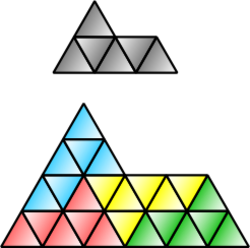Sphinx tiling
From HandWiki
Short description: Type of tessallation

In geometry, the sphinx tiling is a tessellation of the plane using the "sphinx", a pentagonal hexiamond formed by gluing six equilateral triangles together. The resultant shape is named for its reminiscence to the Great Sphinx at Giza. A sphinx can be dissected into any square number of copies of itself,[1] some of them mirror images, and repeating this process leads to a non-periodic tiling of the plane. The sphinx is therefore a rep-tile (a self-replicating tessellation).[2] It is one of few known pentagonal rep-tiles and is the only known pentagonal rep-tile whose sub-copies are equal in size.[3]
See also
References
- ↑ Niţică, Viorel (2003), "Rep-tiles revisited", MASS selecta, Providence, RI: American Mathematical Society, pp. 205–217.
- ↑ Godrèche, C. (1989), "The sphinx: a limit-periodic tiling of the plane", Journal of Physics A: Mathematical and General 22 (24): L1163–L1166, doi:10.1088/0305-4470/22/24/006
- ↑ Martin, Andy (2003), "The sphinx task centre problem", in Pritchard, Chris, The Changing Shape of Geometry, MAA Spectrum, Cambridge University Press, pp. 371–378, ISBN 9780521531627
External links
- Mathematics Centre Sphinx Album ... [1]
- Weisstein, Eric W.. "Sphinx". http://mathworld.wolfram.com/Sphinx.html.
 |




